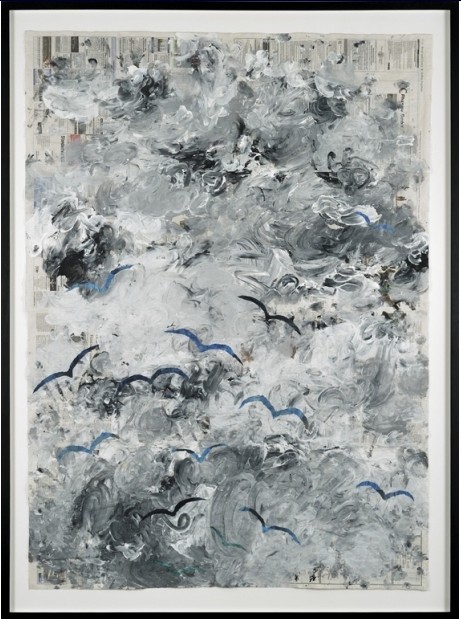Gabriel Vormstein
01 Apr - 07 May 2011
GABRIEL VORMSTEIN
Catch as Catch Can
1 April – 7 May, 2011
Gabriel Vormstein’s material gestures – his effortless watercolour sketches on re-used newsprint or the totemic objects made out of branches and found objects – appear quite laconic and ephemeral. A rectangle made out of a few wooden branches seems hardly more than a few pieces of wood and a length of tape, yet, with some art historical information added, becomes a surprising take on Minimalism and display. Similarly, the carelessness of execution in the paintings seems slightly at odds with some of their motifs and sources, with the rich detail and the luscious surfaces that we all remember from the portraits by Egon Schiele or from flower still lifes. However, Vormstein’s paintings are about the experience of art, about looking at a surface and seeing something other than just paint. They contain a memory of art, a youthful fascination with beauty past, and translate that into a contemporary expression.
Vormstein draws and paints on sheets of newsprint, of mostly four newspaper double-spreads glued together. He sometimes primes these with emulsion paint but never disavows their nature – and so the graphic structure of headlines and columns, images and text becomes the sublayer of all his works. He then draws on these with pencil and fills them with colour, sometimes adding further layers by collageing a background or creating a form. The birds in The Storm and the body of The Hungry Caterpillar are torn from previous, “failed” pieces, thus referencing the ‘masters’ and reanimating his own ongoing involvement.
It is a long process of negotiation. Schiele plays a significant part in this, he is inspiration and at the same time the embodiment of art. Vormstein quotes his figures and uses them as a marker, he refers to their historicity and to the theme of vanitas. In She’s not dead, he outlines one of Schiele’s female figures in pencil, and then adds colour only to what is not her skin, her hair, her dress and stockings, her lipstick and eyes, almost as if she herself had become invisible – a faint memory of a woman who must have died many years ago. The watercolours around her have mixed and bled, they dried in the ‘waves’ of the warped paper and bear hardly any resemblance to the carefully painted original. Yet still, she is there and highly visible, and She’s not dead at all! In Catch up, he again references a painting, this time by Francis Picabia, Catch as Catch Can (1913), that provided the name for this exhibition. Already in the cubist original, Picabia combined forms from wrestling and dance, and Vormstein is now re-aligning traces of that fusion of cultural experiences into the multitude of divergent experiences we are facing today.
Axel LAPP
Catch as Catch Can
1 April – 7 May, 2011
Gabriel Vormstein’s material gestures – his effortless watercolour sketches on re-used newsprint or the totemic objects made out of branches and found objects – appear quite laconic and ephemeral. A rectangle made out of a few wooden branches seems hardly more than a few pieces of wood and a length of tape, yet, with some art historical information added, becomes a surprising take on Minimalism and display. Similarly, the carelessness of execution in the paintings seems slightly at odds with some of their motifs and sources, with the rich detail and the luscious surfaces that we all remember from the portraits by Egon Schiele or from flower still lifes. However, Vormstein’s paintings are about the experience of art, about looking at a surface and seeing something other than just paint. They contain a memory of art, a youthful fascination with beauty past, and translate that into a contemporary expression.
Vormstein draws and paints on sheets of newsprint, of mostly four newspaper double-spreads glued together. He sometimes primes these with emulsion paint but never disavows their nature – and so the graphic structure of headlines and columns, images and text becomes the sublayer of all his works. He then draws on these with pencil and fills them with colour, sometimes adding further layers by collageing a background or creating a form. The birds in The Storm and the body of The Hungry Caterpillar are torn from previous, “failed” pieces, thus referencing the ‘masters’ and reanimating his own ongoing involvement.
It is a long process of negotiation. Schiele plays a significant part in this, he is inspiration and at the same time the embodiment of art. Vormstein quotes his figures and uses them as a marker, he refers to their historicity and to the theme of vanitas. In She’s not dead, he outlines one of Schiele’s female figures in pencil, and then adds colour only to what is not her skin, her hair, her dress and stockings, her lipstick and eyes, almost as if she herself had become invisible – a faint memory of a woman who must have died many years ago. The watercolours around her have mixed and bled, they dried in the ‘waves’ of the warped paper and bear hardly any resemblance to the carefully painted original. Yet still, she is there and highly visible, and She’s not dead at all! In Catch up, he again references a painting, this time by Francis Picabia, Catch as Catch Can (1913), that provided the name for this exhibition. Already in the cubist original, Picabia combined forms from wrestling and dance, and Vormstein is now re-aligning traces of that fusion of cultural experiences into the multitude of divergent experiences we are facing today.
Axel LAPP

